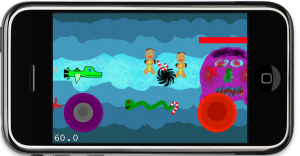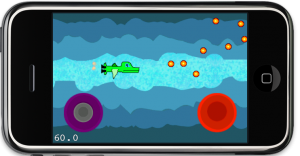Linkvent Calendar, Day 20: Create a Complete Game Tutorial
Mohammad Azam is working on a serious of Tutorials with the goal to write a complete iPhone game, called Space Demon. You can view a demonstration of the game here:
So far, the Tutorial has 3 parts:
Chapter 9 - Particle Effects
Those tiny specks which you can see on your touchscreen after a sneeze.
Not exactly. Of course I mean the cocos2d particle system and its built-in particle effects which will be the focus of this chapter. And no discussion of particles would be complete without describing the workflow revolving around the Particle Designer tool.
Summary of working on Chapter 8 - Shoot ’em Up
This certainly wasn’t the easiest chapter for me to write. I had very ambitious goals, maybe too ambitious for 27 pages. I did manage to sneak in quite a lot though, here’s a partial list:
- how to refactor existing code to make it work better with the new features
- how to pool bullets and enemies together for easier access and better performance
- how to not use too many subclasses, instead relying on type switches
- how to use cocos2d’s node hierarchy as a simple component system for writing reusable game logic components
- how to implement basic movement, shooting and a healthbar as components
- how to detect collisions between bullets and enemies
 The not so easy part was striking the right balance. Not going too technical. Not doing too much at once. Not dividing things into too many tiny pieces. But most of all I frequently encountered various bugs in the code, or just unexpected behavior of cocos2d which forced me to spend more time debugging and sometimes backtracking changes than I was prepared for.
The not so easy part was striking the right balance. Not going too technical. Not doing too much at once. Not dividing things into too many tiny pieces. But most of all I frequently encountered various bugs in the code, or just unexpected behavior of cocos2d which forced me to spend more time debugging and sometimes backtracking changes than I was prepared for.
After a long and hard work week, paired with physical exhaustion and an late-summer allergy burst, my concentration didn’t allow me to work at 100% capacity. In the end I did manage but it took longer than I had planned, I’m over a day late to submit this chapter. The next one will be easier though, and it has to be as I’m preparing for a short trip near the end of next week. I certainly am looking forward to a couple days off now. 
Chapter 8 - Shoot ’em Up
This chapter will finish the shoot ’em up game. There will be enemies and powerups. It raises the issue of good code design when certain things like shooting and moving are common to all objects while other things such as what to shoot and where from and to depend on who is shooting. And then to determine who is hit by whose bullets.
Of course no shoot ’em up game is complete with a boss monster that takes a couple hits to kill. So it’ll need a healthbar. At the end of the chapter this shoot’ em up should be a fully playable game, with Chapter 9 complementing it with visual effects by using the cocos2d particle system. But I’m getting ahead of myself here.
Summary of working on Chapter 7 - Scrolling With Joy
Once again I renamed the chapter a bit since it’s divided into two parts: a parallax, infinitely scrolling background and input via SneakyInput, featuring a fire button and an analog thumbstick respectively at the end changed to a 8-way digital pad.
 The parallax scrolling background consists of several bands or stripes which were created on different layers each in Seashore and then saved as individual 480×320 images. They were then added to the Texture Atlas by Zwoptex. The cool thing about this is that Zwoptex preserves the original image’s size while stripping away all transparent parts. So the images take up little space in the Texture Atlas but in game you don’t have to position them individually, you’ll simply place them at the center of the screen.
The parallax scrolling background consists of several bands or stripes which were created on different layers each in Seashore and then saved as individual 480×320 images. They were then added to the Texture Atlas by Zwoptex. The cool thing about this is that Zwoptex preserves the original image’s size while stripping away all transparent parts. So the images take up little space in the Texture Atlas but in game you don’t have to position them individually, you’ll simply place them at the center of the screen.
To achieve the endless scrolling effect two of each image where added side-by-side to each other, with one flipped on the X axis so the images align neatly. Whenever one image has scrolled outside the screen it is moved back to the right side of the screen. At the end I also fixed the vertical flicker lines which can appear due to round-off errors when moving the sprites. And of course they all are drawn with a CCSpriteBatchNode.
The SneakyInput fire button allows continuous shooting and faster shooting when you just tap it, while the thumb stick controls the ship’s movement in both analog and digital (8-way) variants. The Ship class’ setPosition method is overridden to keep the player’s ship within screen boundaries at all times. Finally an extension class gives SneakyInput the same autorelease initializers used by cocos2d, and adds another good example of just how useful Objective-C categories can be.












